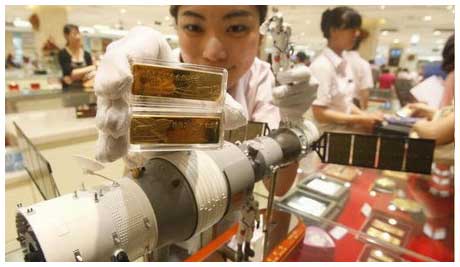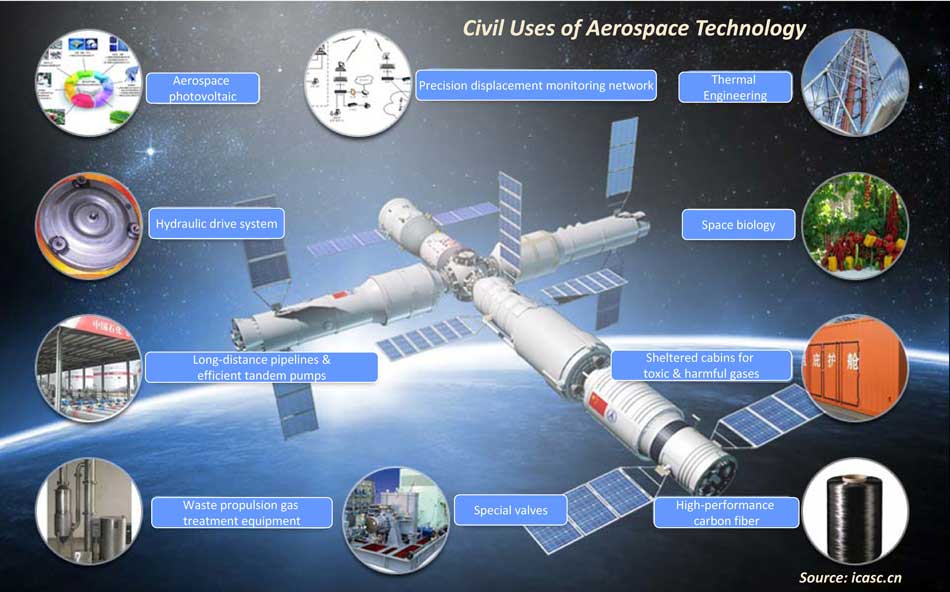

|
China's first manual space docking successful Three Chinese astronauts Sunday successfully completed a manual docking between the Shenzhou IX spacecraft and the orbiting Tiangong-1 lab module, the first such attempt in China's history of space exploration. [Full story] China sends first female astronaut into space China's fourth manned spacecraft, the Shenzhou IX, carrying female astronaut Liu Yang and male astronauts Jing Haipeng and Liu Wang, blasted off from the Jiuquan Satellite Launch Center in Gansu province. The crew will stay in space for more than 10 days, during which time they will perform scientific experiments and the country's first manual space docking. [Full story] Special Coverage: China Launches Shenzhou IX Spacecraft |

 |
 |
| Shenzhou IX gold bars go sale | Commemoratory stamp folders of the Shenzhou IX hit the market |
Space economy to boom in China
The successful launch of the Shenzhou IX spacecraft indicates China's economic infrastructure and technology have made great progress and the country is ready to explore aerospace economy, reported Economic Information Daily on Monday.
According to a report by China Aerospace Science and Technology Corporation, 80 percent of the more than 1,000 types of new material developed in China in recent years benefited from space technology, and nearly 2,000 kinds of space technology have been adopted in various sectors of the national economy. [Full story]

Shenzhou IX launch to boost aerospace shares
The launch of the Shenzhou IX spacecraft in mid-June will drive the aerospace sector in the A-share market to rocket, Western China Metropolis Daily reported on Monday.
The aerospace stocks have a higher probability to outperform the market before a launch, but after the launch, almost all the related stocks would fall, concluded Wang Tianyi, an analyst at Orient Securities Co Ltd, after comparing the performance of aerospace stocks with the market during the last several launches, ranging from Shenzhou IV to Shenzhou VII.
Therefore, before the launch of the new Shenzhou spacecraft, the market may resort to similar speculation, but considering the current weak market, the strength of the speculation remains to be seen, Wang said. [Full story]
China Spacesat H1 profits rise 15.2%
China Spacesat Co Ltd, the nation's key developer of small satellites, Saturday reported 15.2-percent profit increase in the first half, due to steady business expansion.
The net profits totaled 113.9 million yuan ($17.8 million) in the first six months, according to its semi-annual report released on the website of the Shanghai Stock Exchange.
The sales revenues of the company reached 1.78 billion yuan in the January-June period, up 19.34 percent year-on-year. [Full story]
New remote-sensing satellite on the job
China's first high-resolution, remote-sensing satellite for civilian use, Ziyuan 3, was put into service on Monday, marking a breakthrough in the country's drive to map the Earth from outer space.
Launched on Jan 9, the satellite was delivered to its primary subscriber, the National Administration of Surveying, Mapping and Geoinformation, on Monday.
"Ziyuan" is Chinese for "resources".
"The satellite shows that China's remote-sensing satellite technology has reached advanced levels," said Hu Yafeng, deputy head of the State Administration of Science, Technology and Industry for National Defense. [Full story]
Beidou navigates path to larger market share
Navigation devices that can receive signals from the Beidou Navigation Satellite System, China's version of the global positioning system, are expected to expand its share significantly in the GPS-dominated market, said experts.
Cao Chong, director of the Advisory Center of China Association for Global Navigation Satellite Systems, told China Daily in an interview that navigation devices that can receive both GPS and Beidou signals will be the most popular.
Cao said such devices are likely to "take a majority share of the market if their prices are lowered following scale-production of chips for Beidou terminals". [Full story]
Compass aims for $61.5b market by 2020
The application of the Compass Navigation Satellite System, a Chinese global navigation system, will create a market as big as 400 billion yuan ($61.54 billion) by the end of 2020, the head of China's navigation management office said.
Compass, also known as the Beidou system, has a similar function to the US-developed Global Positioning System (GPS), the European Union's Galileo and Russia's Global Navigation Satellite System. It provides positioning, navigational and measurement services for military and civilian use. [Full story]

|
Ticker |
Company |
Revenue - Q1 2012 |
Net Profit - Q1 2012 |
Revenue - FY 2011 |
Net Profit-FY 2011 |
Stock Trend |
|
600118 |
China Spacesat |
670.14 |
36.91 |
3,611.26 |
232.56 |
|
|
600151 |
HT-SAAE |
326.31 |
-110.00 |
2,387.16 |
14.79 |
|
|
600343 |
Aerospace Power |
230.29 |
5.48 |
1,232.60 |
55.20 |
|
|
600879 |
China Aerospace Times Electronics |
659.12 |
28.34 |
3,508.90 |
168.43 |
|
|
01185 |
China Energine |
-- |
-- |
HK$406.29 million |
HK$11,472 million |
|
|
0031 |
China Aerospace International |
-- |
-- |
HK$2,187.01million |
HK$404,77 million |
|
|
01045 |
APT Satellite |
-- |
-- |
HK$758.31 million |
HK$280.92 million |
|
|
002405 |
NaviInfo |
175.20 |
60.00 |
867.12 |
281.44 |
|
|
002151 |
BDStar Navigation |
87.24 |
-14.34 |
484.77 |
38.17 |